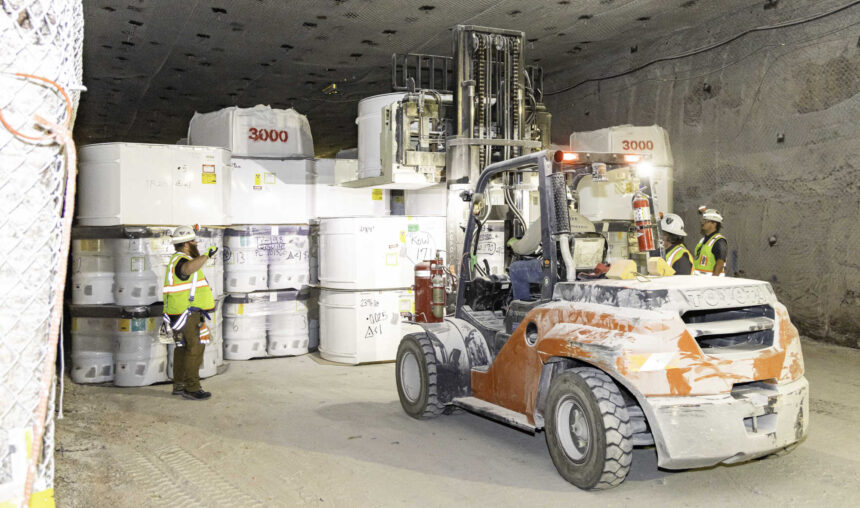Yves here. Nuclear plants seemed destined to stay with us given the need for base load solutions to integrated with renewable sources, which ex hydro, don’t have consistent output. After Germany lost access to cheap Russian gas,1 there was handwringing in Germany about its decision to phase out nuclear power, to the degree that some pundits suggested reversing course. But at that juncture, for reasons over my pay grade, that was no longer possible.
Yet with nuclear destined to be a part of many economies’ energy mix, waste disposal is difficult and controversial. This article covers one pilot program that so far looks pretty successful.
By Sarah Scoles, a science journalist based in Colorado, and a senior contributor to Undark. She is the author of “Making Contact,” “They Are Already Here,” and “Countdown: The Blinding Future of 21st Century Nuclear Weapons.” Originally published at Undark
The land around Carlsbad, New Mexico is spiked with oil and gas wells. Mines hoist up minerals. Hotel parking lots teem with twinning white work trucks, driven by employees who specialize in pulling material out of the Earth.
Amid these extractors, though, are others putting material into the planet: They work for a facility called the Waste Isolation Pilot Plant, located about 40 minutes from downtown Carlsbad. At first glance, WIPP resembles a normal industrial site: A road sign near the entrance sports its inscrutable name, pointing toward tan warehouse-like buildings, evaporation ponds, and headframes for hoisting material.
Superficially, it looks like any other mine in the area. But that sameness belies the strangeness of what lies below ground: A huge subterranean salt deposit that stores nuclear waste from the country’s defense projects.
Once the repository is full, the salt will naturally undo the miners’ work: Tunnels and rooms will collapse, entombing the radioactive material and protecting life aboveground. WIPP has buried more than 14,000 shipments of nuclear waste since its start in 1999.
Twenty-five years after that opening, on a chilly March morning, a charter bus carries a crowd of people — some wearing cowboy attire, others in insulated vests zipped over dress shirts — into the parking lot. They congregate next to a semitruck laden with cylindrical cargo containers that sport radioactive warning labels. The labels, it turns out, are just for show. These containers are empty — staged for a photograph as part of WIPP’s 25th anniversary, and these guests have come to mark the occasion.
When the event starts, in a building plunked just before the security gate, Mark Bollinger, head of the Department of Energy’s Environmental Management Carlsbad field office, heads to a lectern.
“This,” he proclaims, “is a celebration.”
Others beg to differ. According to WIPP’s founding documents, the site should be winding down soon: It is a pilot plant — an experiment, a proof-of-concept — these critics argue, not a permanent one. The goal is to show that it is possible to safely store nuclear waste underground, shut the plant down, and seal it off. Initially, the timeline estimated disposal would stop in the middle of this decade, letting earth close around the waste. Over the course of WIPP’s operating life, and drawing on lessons learned here, the United States would identify and open new repositories for America’s nuclear waste.
That’s not exactly what has happened though.
Today, there are no concrete plans for new deep geologic repositories in the U.S. There are no established future sites for the medium-level nuclear waste that WIPP handles, nor for more dangerous radioactive waste, nor for the tens of millions of pounds of spent nuclear fuel from power plants. Indeed, much of the radioactive trash the country has created since the 1940s still lives in temporary storage, spread across the U.S. And officials now expect WIPP could remain open until the 2080s — decades beyond its originally conceived chronology.
The lack of permanent nuclear waste storage in the U.S. isn’t an engineering problem. “It’s not technically difficult,” said Allison Macfarlane, director of the School of Public Policy and Global Affairs at the University of British Columbia, and former chair of the U.S. Nuclear Regulatory Commission.
The solution, she says, is to bury it. The more radioactive, the deeper it goes.
Politically and culturally, however, convincing communities to permanently host nuclear detritus remains difficult, and WIPP is the world’s only operational example of a deep geological repository for nuclear waste — and the only one on the horizon. If officials are to find a post-WIPP solution for the mid-level nuclear waste being stored here — and the other kinds of radioactive discards — they’ll need to study how WIPP came to be, and why Carlsbad residents haven’t put up much of a fuss.
“In any future repository program,” said Matt Bowen, a senior research scholar at the Center on Global Energy Policy at Columbia University and a former official with the National Nuclear Security Administration, “state and local officials are going to want to understand WIPP.”
The idea that you could store nuclear waste in salt dates to the 1950s, when the National Academy of Sciences published a report about radioactive waste disposal, identifying places where nuclear waste could remain undisturbed. Subterranean salt deposits, the panel of experts concluded, were the best spots, geologically speaking.
“The great advantage here is that no water can pass through salt,” read the report. Cracks in the mineral would heal themselves, theoretically helping halt radioactivity’s flow up or down. Salt deposits are also typically in seismically inactive areas, so nothing should shake the dangerous drums. “Abandoned salt mines or cavities especially mined to hold waste are, in essence, long-enduring tanks,” it continued.
Other geologic options that have been floated include crystalline rock, shale or clay, shale over hard rock, and volcanic rock called tuff, all of which can isolate the waste from the outside environment.
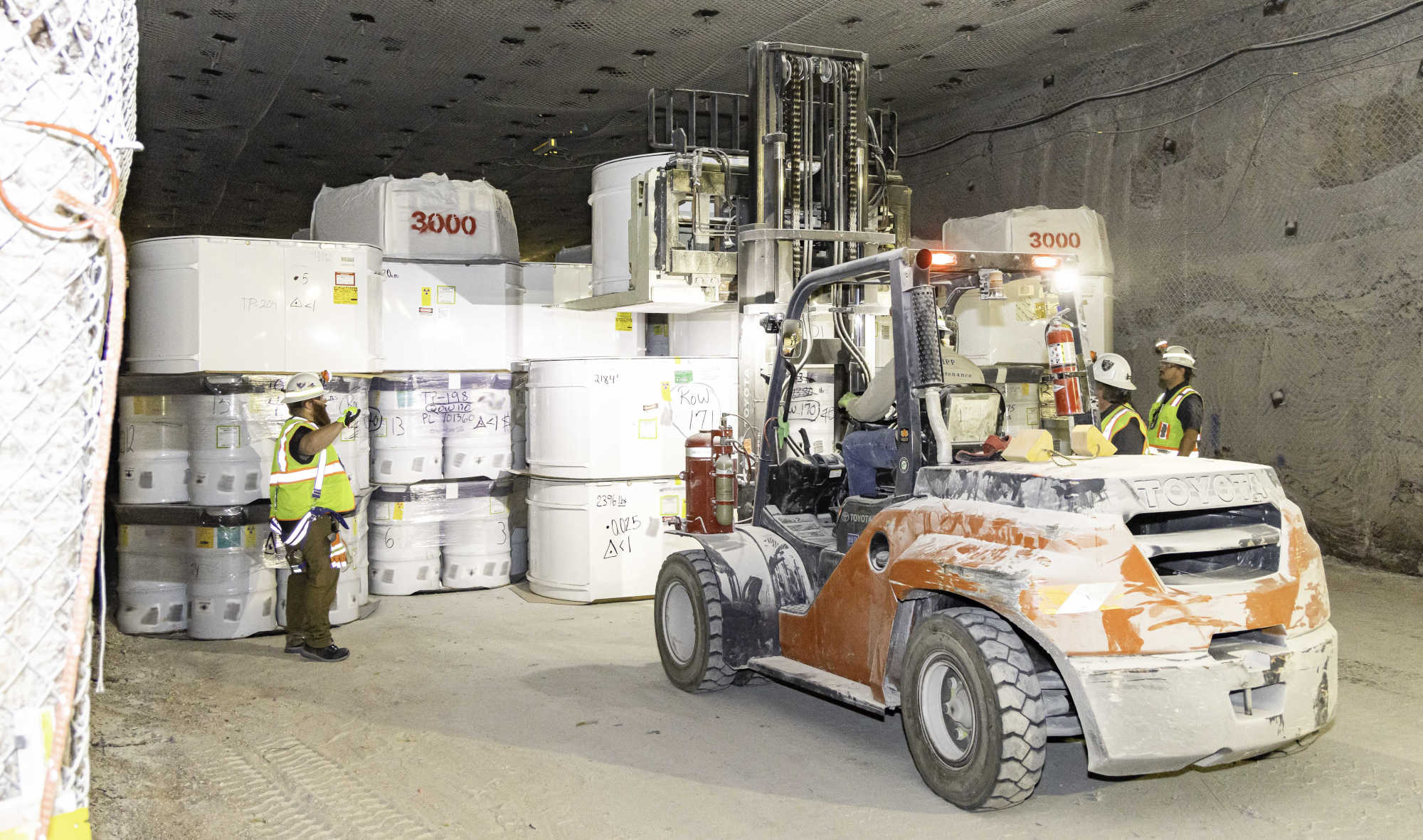
Workers emplace transuranic waste 2,150 feet underground at the Waste Isolation Pilot Plant for permanent safe disposal. WIPP has buried more than 14,000 shipments of nuclear waste since its start in 1999. Visual: Courtesy of WIPP
More than a decade passed before officials implemented the academy’s suggestion, with the defense apparatus continuing to produce nuclear waste the whole time. But when they did move forward with preliminary work in the 1970s, they settled on a part of New Mexico underlain by a huge slab of salt from the long-gone Permian Sea. This salt is 2,000 feet thick, starting 850 feet underground. It seemed perfect.
But first they needed to convince the public.
Proponents and politicians navigated this in part by allowing independent oversight and research and giving the state of New Mexico some power over the process. In the 1970s, the state created a radioactive and hazardous waste committee in the legislature, to recommend legislation for WIPP and for the transportation of radioactive material. And in the 1980s Congress allocated money to mine two shafts through the salt and research the site and its safety, access that allowed the state of New Mexico to do its own, independent research.
That was part of a plan that politicians and policymakers in favor of WIPP had in this era, says former Rep. John Heaton, whose district housed the future site. Namely, that they wanted the public to “hang loose.”
“Let’s not go overboard,” Heaton said of the advice to the public at the time. It is no use thinking of only bad-case scenarios or scary what-ifs. Let’s instead, the advice went, wait for the facts to come in.
As those facts arrived, independent researchers learned about how waste containers corroded over time, and how the underground salt behaved at different temperatures. The research pointed to the long-term safety of the site, and waiting on the scientific results had worked: Carlsbad was on board, with opposition coming mostly from larger, more liberal cities like Santa Fe, where Heaton lives now. And while the project did face controversy and opposition from the state, by the time the project was getting started, more people were in favor of WIPP than against it.
By 1992, politicians had drawn up the Waste Isolation Pilot Plant Land Withdrawal Act, giving more than 10,000 acres to WIPP and laying out its parameters — including the total amount of waste the Department of Energy could “emplace” — a fancy word used to mean “put underground.” WIPP would house material dubbed “transuranic,” largely objects contaminated with radioactive elements heavier than uranium — in this case, mostly plutonium — soiled during nuclear defense work.
(To this day, WIPP only houses transuranic waste with medium radioactivity from nuclear defense projects — not, for example, waste from nuclear energy, or items with very high or low levels of radioactivity. There is no pilot plant for high-level materials in the U.S. at the moment or in the plans.)
Carlsbad, at the time, was a smaller town. Sure, there were mines, agriculture, and some tourism. Later, big oil would come. But WIPP began to change the town’s character: It brought stable income, contractor opportunities, and new residents with high incomes and levels of education. Property values went up.
And so, this spot in the Chihuahuan Desert became the only place in the world built specifically to contain nuclear waste forever, deep underground — at least the only one so far.
Today, WIPP is not just a hole in the ground but a series of tunnels and rooms largely housing barrels filled with pieces of rebar, rags, clothing, empty containers of spray adhesive — remnants of the objects engineers and technicians used while working on nuclear weapons or defense research.
Two days after the 25th anniversary celebration, WIPP has invited officials from the Department of Energy to tour the facility. Early that Thursday morning, the group waits in a security line, along with police officers from South Carolina, also here for their own tour. These law enforcers regulate shipments of nuclear waste that truck through the Palmetto State, with WIPP as their destination, and they want to see where that waste will end up.
In the security office, this motley crew proclaims their U.S. citizenship, and affirms that they are not bringing hazardous materials in. Those details out of the way, they don borrowed yellow vests, safety googles, and hardhats.
A safety video tells them about emergency alarms they may hear, and the carbon monoxide respirators they will carry that, if they had to use them, would heat up and burn their mouths while cleaning the air.
The group soon shuffles to follow the same path nuclear waste would. First, to the unloading area, where a container called a TRUPACT, built to protect and seal off its contents if it’s, say, dropped in water, dropped on a spike, or set on fire — is being readied for emplacement. Workers pull the actual waste — drums arrayed on a kind of lazy Susan — up and out of the TRUPACT shell. It twists like a carnival ride before being lowered onto a platform for processing. The radioactivity of this waste is low enough that the drums themselves are thick enough to shield workers.
The site the waste is coming from (national laboratories like Los Alamos, or other Department of Energy facilities where nuclear weapons work takes place) and WIPP workers both do due diligence to characterize what’s inside these drums, and ensure it is properly packaged. Sometimes that involves watching video of the drums being filled, sent by the facility; sometimes it involves X-rays that produce digital images of a drum’s innards; sometimes, it’s lower tech, like jostling a barrel to see if there’s any liquid, as if it were a cup of dwindling soda.
Technicians also measure the radiation from the waste, to ensure it is within the facility’s medium-radioactivity limits. Perhaps most importantly, they take stock of “fissile material,” which decays by splitting into smaller atoms, to ensure that they can’t start a chain reaction, in which fission begets more fission in a self-sustaining cycle that releases significant radiation.
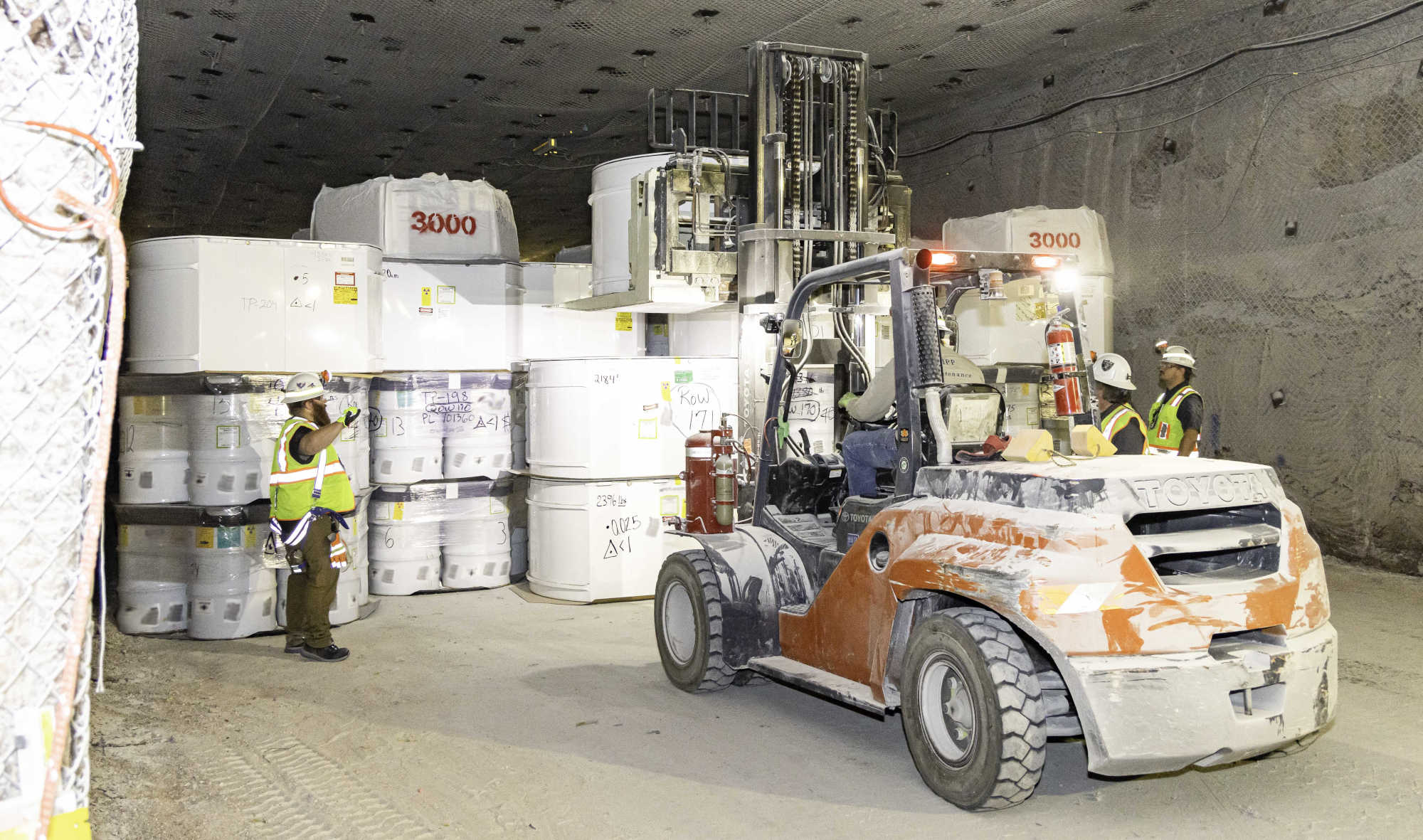
To create the rooms where transuranic waste will be permanently disposed, miners at WIPP excavate salt at more than two thousand feet underground. Visual: Courtesy of WIPP
That’s all difficult for what’s called “legacy waste” — radioactive trash created long ago when records were less detailed and methods less stringent than they are now. Some of it was simply put in containers and buried in shallow trenches, or even above-ground, on the nuclear labs’ property during the Cold War. Legacy material makes up much of WIPP’s contents, and much of what will be in its future deliveries.
For more modern material, also coming from Department of Energy sites that work on weapons, WIPP gets involved from the start — “before we even generate the waste,” explained Tammy Hobbes, vice president at Salado Isolation Mining Contractors, the company that operates WIPP on behalf of the Department of Energy’s Environmental Management office. That involves preemptively characterizing it. “We understand everything about it,” said Hobbes of this newer waste. “The process that was used to make it, how it was accumulated, how it was packaged, how it was sorted, how it was stored.”
No matter when or where the waste comes from, technicians, like those the tour group watches, always test for contamination, any potential leaks from its hazardous cargo into the TRUPACT, which should still contain it. If there’s a positive result, the containers are put back in their TRUPACTs, and go back where they came from, carrying an embarrassing report card home.
Those checks and balances have been fine-tuned since 2014, when WIPP experienced its greatest setback.
February that year was a bad month for the plant. First, a truck hauling salt caught fire underground, spreading soot on important equipment and smoke throughout the site — and endangering the 86 workers underground. Everyone made it the 2,000 feet to the surface, but several had to be treated for smoke inhalation.
Just over a week later, in a different part of WIPP, a drum of waste exploded, turning itself essentially into a dirty bomb, blasting out transuranic radioactive material in a fiery burst.
Twenty-two workers received doses of radiation, and a small amount of contamination escaped into the outside world — about 3 percent of the amount of radiation from a chest X-ray.
The dangerous drum had originally come from Los Alamos, where workers had mixed in the wrong kind of cat litter — a simple substance that typically helps stabilize nuclear waste. But in this case, instead of combining the hazardous substances with inorganic kitty litter, they had mixed it with “an organic kitty litter,” the instructions having gotten garbled. And organic material can react with nitrates, causing chemical reactions that release heat. The increasing heat bumped up the pressure inside the drum, until it burst.
“They were clearly being charged with getting as many shipments done as they possibly could, each year,” said Bollinger. When quantity is the goal, quality can suffer.
After the accident came a yearslong shutdown for WIPP, a period that DOE and WIPP officials usually refer to as “the recovery.” When the facility opened back up, its speed slowed. Today, WIPP receives 17 shipments a week — whereas they were managing more than 30 when the accident happened. “They were hustling, and hustling and hustling,” said Bollinger.
Bowen, the Columbia University research scholar, considers the accidents significant in part because after the “recovery,” there was, actually, a recovery: The facility restarted, and there was not a total revolt from the region’s residents.
“That one was kind of surprising, shocking,” he said. “The community and the state felt like it was a breach of trust.” But, he continued, the relationship between the state, its people, and the feds operating WIPP “was strong enough to survive it.” The site’s shutdown also led to material improvements.
In fact, the accident may actually prolong WIPP’s life: For one, it lost almost three years of operations, so it will take longer to fill the allowed volume of waste. And two, the facility received funds to revamp. “You aren’t going to put a lot of money and upgraded systems and then shut it down,” said Don Hancock, director of the nuclear waste safety program at the nonprofit Southwest Research and Information Center, who advocates for limiting the timeline and contents of the facility.
One of those investments, for example, is the nearly $500 million Safety Significant Confinement Ventilation System, an impressive series of tubes that can suck air from the underground and send it through the one of the world’s largest set of HEPA filters, improving air purifying capacity both in everyday and emergency situations. It comes with a new air shaft.
The system, which boasts pipes so big they tower around humans, would also increase the general airflow underground, allowing WIPP workers to mine salt and emplace waste simultaneously, whereas they currently only have enough air to do one or the other. The system is in the final stages of preparation, before it starts operation.
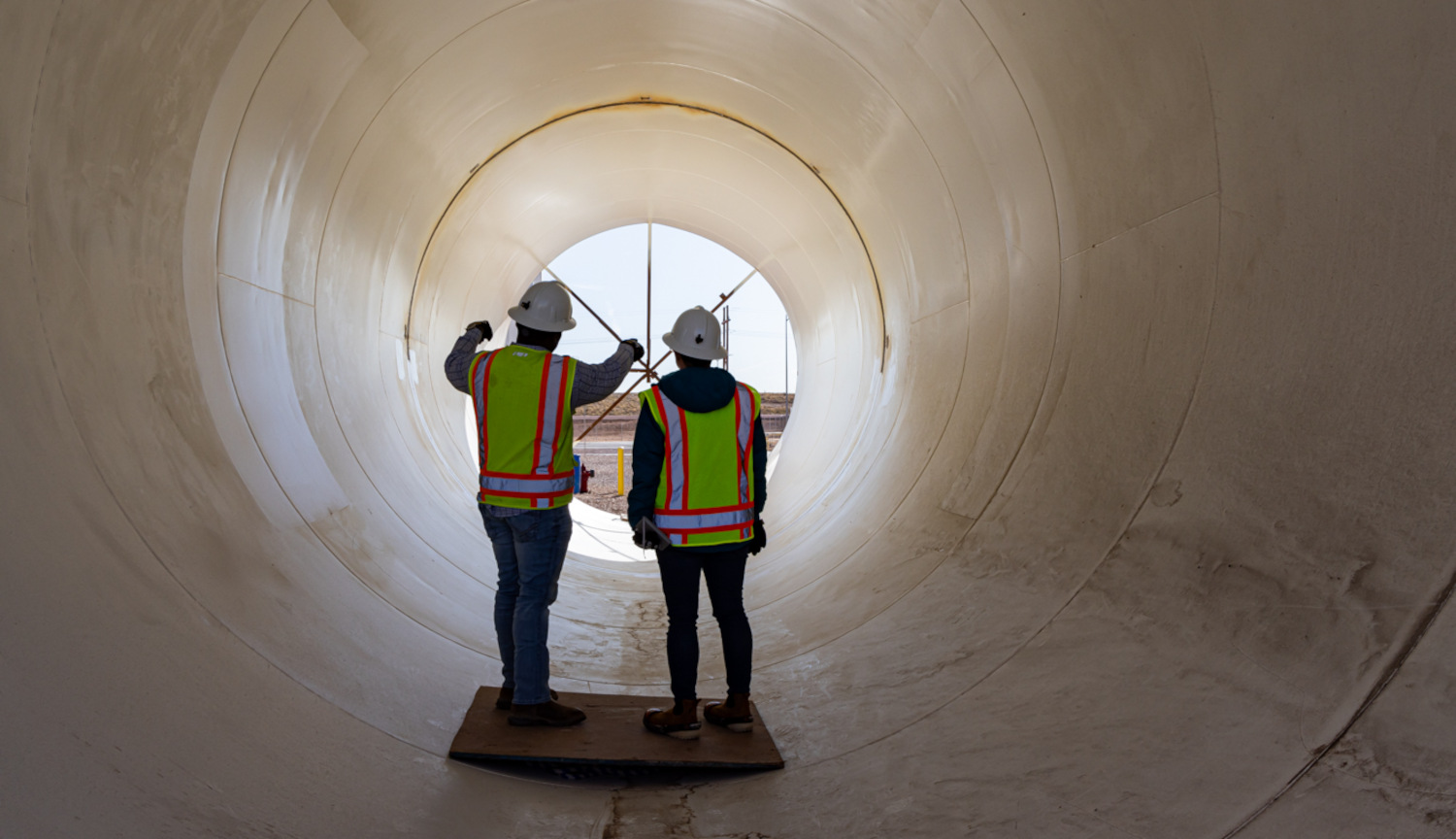
The ventilation ducts of the Safety Significant Confinement Ventilation System are so large, they tower around humans.Visual: Courtesy of WIPP
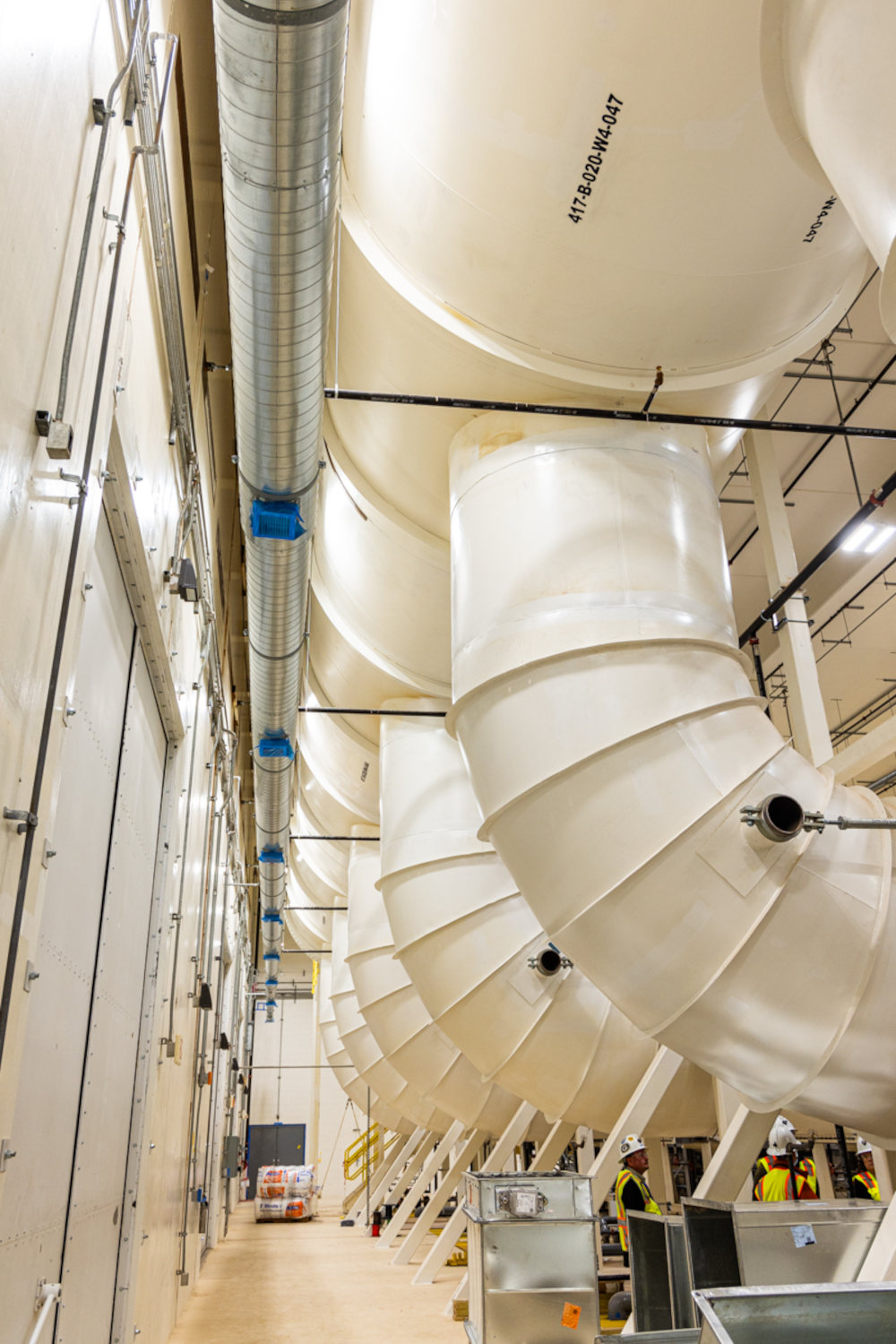
The ventilation system provides air to the underground. Prior to being released to the atmosphere, air is sent through one of the world’s largest set of HEPA filters. Visual: Courtesy of WIPP
The 2014 accidents may have been the most significant in WIPP’s history, but yearly, smaller incidents also occur. “It’s difficult to operate this kind of facility,” said Hancock. “Nobody in the world has ever safely operated a deep geologic repository.”
And that is the difference between the real world and a report from a national academy about what kind of rock or mineral is safe: A place can be perfect in geological theory, but when operated by flawed humans, it will be subject to their mishaps and misjudgments.
Perhaps that is part of why humans have had such a hard time agreeing about where to construct other deep geological repositories, and how to go about building them. Congress, for instance, mandated a facility for high-level waste in Nevada, called Yucca Mountain. After years of work and billions of dollars spent, the project was canceled in 2010. Before WIPP, officials considered an abandoned salt mine in Kansas for a pilot site, but they faced both state opposition and oil and gas wells they hadn’t known about nearby.
Abroad, other countries are making progress on deep underground repositories: In Finland, a permanent facility called Onkalo will soon come online, housing spent nuclear fuel. Sweden, meanwhile, expects to begin operating its Forsmark facility in the 2030s. Canada has narrowed its potential sites to two areas that proactively expressed interest in hosting. In all three cases, having the communities on board has been key to a smooth, if still lengthy, process.
On the tour, the group heads into the underground area where some of these incidents took place. They shuffle to the mine office, where each person is given a brass coin with a unique number. It’s like a dogtag, the administrator explained: If there were a fire, the coin wouldn’t burn. But they would be able to identify the humans who had.
That somber and vivid thought in mind, the group enters the open-cage elevator — which people here like to call “the conveyance” — to descend foot by foot into increasing darkness, the walls of the shaft first lined with metal, then showing their true nature: just salt.
At the bottom, the floor looks like a white-sand beach; the air is hazy with tiny crystals that stick to skin, leaving lips tasting like the ocean. A break area for employees consists of a salty room with salty chairs, salty picnic tables, and salty cargo containers outfitted with refrigerators and microwaves. Visitors can pluck (radioactively safe) salt from the ground and take it home in a WIPP-branded Ziploc.
“Welcome to the WIPP underground,” a sign proclaims. “You have just entered an environment committed to safety.”
Above, giant bolts poke from the ceiling and extend deep into the salt, helping hold it up by transferring some of the load farther into the material. The salt is constantly shifting, creeping, wanting to fall.
That’s good for the future: When WIPP is full, and operations shut down, that crackle and pop will seal waste off from the surface, thousands of feet above. But it’s worrisome when people are still working down here, among unnerving cracks and buckles in the walls. A 2014 National Academy of Engineering report noted that this creep makes salt “poorly suited for keeping the cavity open for monitoring and retrievability.”
The salt’s geologic movements are the primary concern in the near-term, and so they are monitored, pointing engineers to where they should place the bolstering bolts where they’re necessary for stability. Sometimes, though, not well enough: Since 2014, there have been several collapses. One happened near the area of the accident, which, since it was designated dangerous to workers, hasn’t seen the intended maintenance, contaminated as it was. In whatever nuclear waste repositories populate the future, figuring out how to keep them stable — perhaps for much longer than is required of WIPP — will be important.
That coiled threat above the tour group’s heads, the officials creep in electric carts. They head toward an area where technicians are currently emplacing waste, where drums of nuclear waste are stacked three-high and honeycombed from front to back. The group, disembarking the cart, march toward this battalion of barrels, accompanied by a radiological control technician who keeps watch on their doses.
If all goes as planned, the group is looking at where this waste will live forever, salt eventually crashing down on top of it. The infrastructure above will be dismantled, the entrances sealed, and signage placed atop warning would-be visitors for the next 10,000 years to stay away.
Despite the accidents, WIPP is generally viewed as an experiment that’s working. WIPP’s groundwater, sediment, surface water, soil and vegetation, and air, among other things, are monitored for contamination that has not come — measurements verified by a regular Environmental Protection Agency review. And even its biggest accident — while terrifying — kept radioactive releases below the allowed levels.
“I look at it as a successful project,” said Bowen, who toured the site a few weeks after the anniversary.
Bowen’s research deals in part with how to make future repositories successful, and he recently published a paper about a policy path forward — so that, ideally, those repositories will someday actually exist, or at least be on the drawing board.
WIPP, his most recent study claims, “presents proof that the United States is capable of certifying, constructing, and operating a facility deep underground for disposal of long-lived nuclear waste — and, importantly, is able to maintain long-term community support for the program.” That support is what makes it a success, he says. The state, with input from the public, has to concur with the Department of Energy on permitting the site every 10 years. It’s one aspect of a technique both policymakers and researchers like Bowen now call “consent-based siting.”
Carlsbad, and its state-level overseers, consented. While they do not have full control over the site, the state and the Department of Energy have to agree on the parameters of the permit — and WIPP can’t operate without the state’s permit and so its permission. The task of reaching agreement is probably simpler than in other places, Bowen observed, because the area is acclimated to other extractive industries, which are risky and prone to contamination whether they involve nuclear waste or not.
In Carlsbad, there doesn’t seem to be much angst to speak of. WIPP provides 1,700 solid-paying jobs that are mostly in Carlsbad — a lot for a town of around 33,000. “We’ve got 25-year-old rocket scientists coming in here, and nuclear scientists, and hydrologists, and civil engineers and mechanical engineers,” said the CEO of the chamber of commerce, Chad Ingram.
Most of the opposition comes, instead, from outside. At public meetings about WIPP, local dissenters are rare. Many live in Santa Fe, a place local WIPP supporters speak of almost as if they exist on a separate planet.
The critiques these dissenters levy, though, aren’t black-and-white, not taking the form of “no nuclear waste disposal!” Critics, like proponents, want the legacy waste cleaned up, and safely. But they don’t trust WIPP with that last part. While the bigger cities in the region are unlikely to suffer ill effects from a disaster at the plant itself, trucks of nuclear waste pass through on their highways. And some residents are concerned about the safety of those trucks. Any vehicle traveling anywhere, carrying anything, can have an accident.
They are also worried about WIPP’s proximity to oil and gas activity. When the site was chosen, WIPP’s surrounding area didn’t have that kind of industry it has now. Today, the fossil fuel wells whir in every direction across the desert landscape. Given the new underground activity — and how it might expand in the future — people are concerned that the drilling may come too close to the WIPP site. “There will be inadvertent or advertent intrusion,” said Hancock.
That’s a concern for any future waste sites: Who knows what will happen, anywhere, in 100, let alone 10,000, years? And it’s of particular concern if future sites are also salt-based, since those places are where oil and gas reserves tend to reside too, according to the Nuclear Energy Agency.
Those opposed to WIPP’s operation also point to perceived creep from the Department of Energy. For instance, the law setting WIPP up declared that it could hold up to around 180,000 cubic meters of waste. Officials originally estimated it would take around 25 years to emplace that much. But in reality, it’s taken more time — with the facility set to remain open longer than expected, and new kinds of waste that would require permit modifications.
Earlier documents estimated WIPP would begin the closure process around this year, having filled itself to capacity. But since WIPP hasn’t hit its volume cap, operations can continue, leaving some, like Hancock, upset at what he sees as an extension. “They think they can get away with it,” he said.
If the Department of Energy didn’t keep WIPP open, though, there would be nowhere to put the old transuranic waste that still needs a permanent home, or the new waste piling up: The U.S. is preparing to make plutonium pits, the cores of nuclear weapons, for the first time in decades. Castoffs from that work will end up here at WIPP. And the stakes of figuring out where nuclear waste goes, according to Macfarlane, the former U.S. Nuclear Regulatory Commission chair, are high.
“Otherwise,” she said, “it will eventually get into the environment and impact human health.”
WIPP recently received its latest 10-year operating permit from the state of New Mexico. As part of the final agreement, the DOE agreed to look for a future waste-disposal site, in another state. “I think it will be a consent-based siting program,” said Bowen, of repositories to come. “I don’t think anybody wants to fight states.”
But it will be hard to find a new, permanent place — or other places for the other kinds of nuclear waste out there. “At some point in time, we’re going to have to start this effort of establishing another deep geologic repository,” said Bowen. WIPP, after all, took decades to open, so starting now could mean getting a new space in the 2040s or 2050s, with more waste piling up in the meantime. “We need to get going on that,” he continued. He’s hopeful things may get started in 2025.
And as with WIPP, the hardest part won’t be finding more salt spots, or deciding between volcanic rock and shale: It will be getting the people sitting in Washington and the people living atop those deposits to agree to something. “The affected public has to trust those who are implementing this process and those who are regulating this process,” said Macfarlane.
But the requirement goes the other way, she added: The implementers and regulators have to trust the public. That latter part often falls apart, she said.
Both sides of the process could probably use some bolstering bolts. But where and how to place them — literally and figuratively — remain open questions. And WIPP is the only place in the U.S. that provides some potential answers, buried beneath its desert surface.
It’s hard, at this underground hideaway, not to think of another subterranean spot nearby: the famous Carlsbad Caverns. It’s a deep geological repository of another sort, storing the planet’s secrets. A teenage cowboy and his friend found it in 1898, as they were rounding up their herd and noticed smoke coming from the ground. Thinking it was a fire, they went toward it. But instead of flames, they saw a flurry of bats emerge from a large hole in the ground. Later, the boy came back with wire, wood, and a lantern. Building himself a ladder, he descended underground.
What he discovered, secreted away, were phallic and swordlike stalactites and stalagmites, speleothems gathered like monoliths, glass-clear springs. It was a whole world where time moved differently: slowly, unbothered by what the humans above did — at least until they descended and discovered it and built a gift shop on top.
WIPP, built on human timescales and with human-made material inside, could be considered the caverns’ opposite. And officials hope it remains so in its conclusion: unexplored, and unappealing to those who might come upon it in the future.
In the 1990s, Sandia National Laboratories convened linguists, scientists, and anthropologists, among others, to figure out how to separate WIPP from the people of the future. They came up with a plan involving signs and symbols: The site will be surrounded by huge earthen berms, metal objects and magnets buried within, meant to reflect radar beams and make this place register as magnetically anomalous. The perimeter will also host 25-foot-tall granite columns, engraved with warnings, and no-go markers will be buried up to six feet deep throughout the site. WIPP’s center, if someone gets that far, will host an information center that includes pictorial messages today’s humans hope will convey “leave this alone” to future ones.
“Other nuclear waste disposal sites must be marked in a similar manner within the U.S. and preferably world-wide,” read the multidisciplinary report. Its authors likely imagined there would be plans for such sites by now, and that WIPP would soon be getting its warnings. But it got, instead, a birthday party.
____
1 Note our deferential lack of agency.

